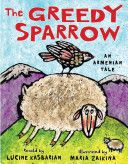
The Greedy Sparrow
Retold by Lucine Kasbarian
Illustrated by Maria Zaikina
Marshall Cavendish, 2011, n.p.
ISBN: 978-0761458210
Once there was and was not. (n.p.)
With this traditional Armenian beginning “to suggest that fantastical tales may be real or imagined,” the story opens with a small sparrow with a thorn in his foot. He goes to a friendly baker who removes the thorn only to return later to the baker and demand that she give him the thorn or a loaf of bread in its place. Of course, the thorn was thrown away so the small bird leaves carrying a fine loaf of bread. The story continues as he asks a shepherd to watch the bread and returning, he demands a sheep when he finds out the shepherd has eaten the bread. The plot continues to build as the sparrow collects a bride and a lute and only ends when he eventually falls from a tree, losing the lute and gaining another thorn in his foot. This tale of the outcomes of greed is part of Armenian oral traditions and was originally written down by Hovannes Toumanian, an Armenian poet who lived from 1869 – 1923, according to the author’s note.
The authenticity of this story as part of Armenian oral traditions can be traced to author Lucine Kasbarian’s grandmother who was a celebrated storyteller within her culture. Following the Armenian genocide in the early 20th century, the author’s family fled Armenia with only a few papers and their knowledge of the songs, dances, foods and other cultural artifacts that represented their heritage. Retelling traditional stories such as The Greedy Sparrow provided one way to maintain a piece of Armenian culture for generations that followed. The illustrator, Maria Zaikina, is Russian; however, she researched the Armenian culture even before being selected to create the rich representations of traditional life that the reader finds in The Greedy Sparrow (http://www.lucinekasbarian.com/files/GreedySparrowRelease.pdf).
The Greedy Sparrow has won several awards, including the Silver Nautilus Award in the children’s book category, an award given for positive social change. The press release for this award states, “Author Kasbarian and illustrator Zaikina convey ethnic authenticity in their adaptation of this tale from the Armenian oral tradition.” It was also an honor book for the 2012 Storytelling World Resources Award.
True to the nature of storytelling, the text of The Greedy Sparrow is simple. Narrator lines are provided at the top of each page while speech bubbles emphasize the voices of the characters. True to the nature of picture books, Maria Zaikina’s bold, colorful, folk-style illustrations help relay the meaning and humorous tone of the story. The illustrations are created with oil paint and layers of wax while characters, landscape, and cultural artifacts are each outlined in thick black lines. Each page is similarly outlined.
Creating a text set of Armenian picture books would be one way to both enjoy the traditional lore of Armenia as well as make readers familiar with the traditions of this particular culture of the global community. Other books that might be included are suggested on Kasbarian’s website, such as Once There Was and Was Not, A Modern Day Folktale from Aremenia (Page McBrier, 2008); A Drop of Honey (Djemma Bider, 1989); A Donkey Reads (Muriel Mandell, 2011); Gadoo the Cat, Armenian Folktale (Susan Kadian Gopigian, 2008); The Flower of Paradise and Other Armenian Tales (Bonnie Marshall, 2007) and One Fine Day (Nonny Hogrogrian, 1971). Older students might want to explore Aremenia: A Rugged Land, an Enduring People (Lucine Kasbarian, 1997) to learn more of this culture. Readers might also enjoy visiting other traditional tales in which morals are embedded within the outcome, such as Aesop’s Fables or Fables by Arnold Lobel (1983).
Janelle Mathis, University of North Texas, Denton, TX
WOW Review, Volume VI, Issue 1 by Worlds of Words is licensed under a Creative Commons Attribution-NonCommercial-ShareAlike 4.0 International License. Based on work at https://wowlit.org/on-line-publications/review/vi-1/

Dear Ms. Wilson,
I would be grateful for some details – which are the facts that I neglected to look up, specifically on Wikipedia?
The novel was written in 2005 and I consulted countless books and other media in order to describe two Jewish families in the 1930s and 1940s as credibly as possible. A good deal of the two years of writing this novel (the German original being much longer than the American edition) was spent on research in Berlin and London. Before going into print, the finished novel was read and approved by two scholars with a degree in Judaism. One of them spent most of her life in Israel.
I am very sorry for any mistake which remained in the book, also for maybe not quite catching the spirit of being Jewish in Britain in the 1940s.
With best wishes,
Anne Voorhoeve